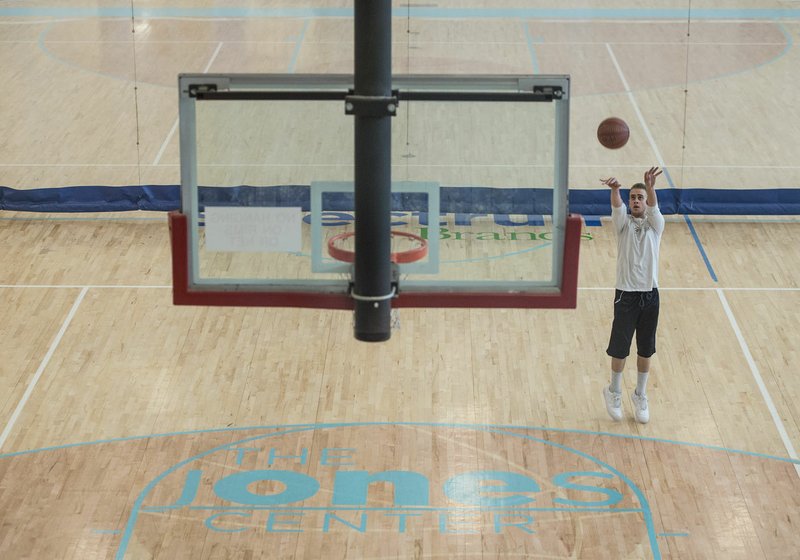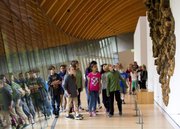Cultural attractions, miles of trails, access to quality health care and education and other benefits have helped give most Benton and Washington county residents a high quality of life, according to a report released Monday by the Walton Family Foundation.
The foundation's 2015 Quality of Life Survey Report found 95 percent of more than 1,000 respondents last fall were "very" or "fairly" happy to live in Northwest Arkansas, with about three-quarters rating their quality of life as "excellent" or "very good." The high ratings are likely thanks in part to regional amenities the foundation helped pay for during the past several years, according to the report.
At a glance
Northwest Arkansas resident quality of life
Level;Percent of respondents in 2015*;Percent in 2012
Excellent;33;26
Very good;39;33
Good;20;26
Fair;5;11
Poor;2;4
- 2015 numbers do not add up to 100 percent because of rounding when determining percentages.
Source: Walton Family Foundation Quality of Life Survey Report
The Walton Foundation has given almost $100 million in grants since 2013 toward trails, museums, performance centers and other efforts. It commissioned the report as both a quality of life yardstick and an assessment of how well those dollars are working and where they might go next, said Karen Minkel, the group's home region program director.
"I think in some ways there's validation for us. We've made significant investments in a lot of these entities, and to see the work they're doing being recognized by the community is tremendous," she said. "This is an opportunity for all of us to look at our work."
The Survey Research Laboratory at Mississippi State University carried out the survey among a representative sample of people aged 20 to 64 years and used questions similar to other quality of life surveys across the country to give an objective and reliable report, Minkel said.
Among other findings, the report shows about 83 percent of respondents visited local parks in the previous 12 months, while 69 percent reported using the area's trails. Both numbers were up slightly from 2012 when the foundation did its first quality of life survey, also by the Mississippi lab.
The survey found a significantly lower percentage of residents visited Springdale's Jones Center, which provides exercise, after-school programs and other services and is temporarily home to several schools, including a School of Innovation for almost 350 students. Use dropped from 41 percent in 2012 to 27 percent, according to the report.
Ed Clifford, the center's president, said more people than ever are coming through its doors, but the fact many of them are the same students every day, along with increasing population, might be driving down the percentage of individual visitors.
"The visits compared to 2012 are probably double; we do more programs all the time," Clifford said, noting about 10,000 people are expected for Saturday's Cinco de Mayo celebration. "We are swamped all the time now."
Springdale lagged behind the other three major cities with about half its residents using a trail, according to the report. At the other end, about 81 percent of Bentonville's residents used their trails, with Fayetteville coming up second with 71 percent. Springdale also has the fewest miles of trails: about 10, compared to at least three times that in the other cities.
Springdale spokeswoman Melissa Reeves said people are becoming accustomed to the Razorback Greenway, a project that opened through the city a year ago and received a $15 million Walton Foundation grant. The city plans to build additional trails out from the greenway backbone as well, Reeves said.
"Going forward I think you'll see a lot more trail usage in Springdale," she said.
More people are also heading to other attractions and amenities, with the portion visiting Crystal Bridges Museum of American Art reaching 63 percent, about 20 percentage points higher than the foundation's earlier report. A third also said they were going to downtown districts more often in the past year, with most of the rest going about the same amount.
Most praised the ease of accessing health care services as well, though some called for more mental health care.
The survey found several other areas people wanted to improve as well, particularly in education and travel. Almost three-quarters said pre-kindergarten and daycare weren't affordable, and while most said the area offered high-quality education at all levels, half said more school choice could make it even better.
A majority said Northwest Arkansas Regional Airport's flights were too expensive and didn't go to enough places. And more mass transit was one of the top wishes among respondents -- second only to a major league sports team.
"It's really cool to see that we're part of the conversation," said Joel Gardner, executive director of Ozark Regional Transit. The service provides more than a dozen bus routes throughout Benton and Washington counties, and ridership reached almost 80,500 in the first quarter of this year, up almost 12 percent from the year before, according to data released last week.
The $3 million transit service could grow much more with a dedicated, long-term source of local public money instead of year-to-year allocations, Gardner said. He envisioned dozens of routes through the two counties, with buses every few minutes instead of half an hour to an hour of wait-time.
If such a program were put together gradually and well, "the potential for growth is unbelievable," Gardner said.
Though people of all income levels take advantage of what the area has to offer, the lower someone's income, the less likely they were to use even free amenities, the survey found. Kevin Fitzpatrick, a sociology professor at the University of Arkansas who organizes the regular homeless census in the two counties, said time is often the deciding factor among people with low incomes.
"They're not just working one job, they're working two or three," he said, adding public transit could help make cultural amenities easier to reach. Health care and education are more urgent than parks and museums, Fitzpatrick added. "Amenities like building a mountain bike trail system -- it's not for people who are struggling to make ends meet."
Deep-seated challenges such as low income require the Walton Foundation and others across the region to work together, Minkel said.
"With any of these huge issues, whether its transportation or early childhood care, there aren't solutions that one entity can do alone," she said, adding Monday's report can help all charitable groups in the area steer their work. "It points us to areas that perhaps we need to research further."
NW News on 05/03/2016



